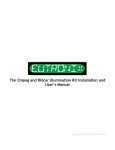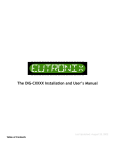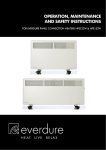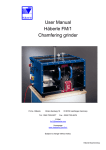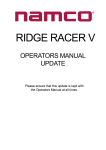Download H-racer
Transcript
User Manual H-racer Made in China www.horizonfuelcell.com The world’s smallest hydrogen car H-racer User Manual Contents: Warning 1. About the H-racer 2. H-racer Assembly Instructions 3. Preparing the Hydrogen Station for operation 4. Creating renewable Hydrogen using power from the sun 5. Refueling and operation 6. Troubleshooting To avoid the risk of property damage, serious injury or death: This kit is intended only for use by persons 12 years old and up, and only under the supervision of adults who have read and understood the instructions provided in the kit’s user manual. Keep children under the age of 8 away as it contains small parts that could be swallowed. The Hydrogen Station generates gases that are very easily ignited. Do not use the Hydrogen Station for any other purpose than refueling the H-racer, as instructed in this user manual. Keep the Hydrogen Station and H-racer away from fire or flame. Read the instructions carefully before use and have them ready for reference. www.horizonfuelcell.com p1 p7 p20 p23 p25 p33 1. About the H-racer The H-racer is a futuristic toy car that contains one of the most exciting and advanced technologies of the 21st century. This car operates on 100% clean fuel produced by a miniature solar-powered hydrogen refueling station that converts water to hydrogen using energy captured from the sun. To help improve the quality of our environment, reduce the impact of soaring energy costs, and decrease our dependence on imported oil, the time is right to start introducing the world to the benefits of hydrogen fuel cell technologies. Cars running on clean and renewable fuel are the ultimate dream of many of today's world leaders, engineers and scientists seeking to eliminate mankind's reliance on fossil fuels in favor of climate-friendly energy resources. With new advances in technology, hydrogen is fast becoming the world's next fuel. Hydrogen offers many important advantages: it is non-toxic, renewable, clean to use, carbon-free, and it is the most abundant element in our universe. By using fuel cell technology to convert hydrogen to electricity without any combustion, this approach offers a significant solution to many of our global energy, environmental and security problems. The only exhaust resulting from hydrogen fuel cell cars is pure water. This is why fuel cell cars that use hydrogen as a fuel are also known as "zero emission vehicles." Most of the world's automotive companies are developing hydrogen fuel cell vehicles with the hope of introducing this revolutionary technology to the public over the next years. The H-racer is the world's smallest hydrogen fuel cell car, and the miniature version of real-size hydrogen powered cars being developed today in laboratories. Although simpler in design, this palm-size fuel cell car contains all the necessary technology to make it run. It includes an on-board hydrogen storage tank, a fuel cell system connected to the car's electric motor, and a hydrogen refueling valve system that can connect the car's storage tank to an external hydrogen refueling station. The H-racer is also very safe. Given its small size, only tiny quantities of hydrogen are needed to power the car. Its only emission is just tiny quantities of pure water that come directly out of the fuel cell during operation. The amount of water produced by the fuel cell power system is so small that you will not even notice it. Why Hydrogen? Our civilization consumes carbon-based fossil fuels 100,000 times faster than they are being made available, raising many questions about global supplies and whether they are able to meet the world's fast-growing global energy demand. With geopolitical uncertainties in oil producing countries and insufficient oil refining capacity, our global economy is already under significant pressure. Oil is critical to the well-being of entire nations, therefore new technologies that can reduce the dependence on imported oil are becoming strategic. National security concerns are now encouraging scientists from all over the world to develop new energy technology solutions such as hydrogen fuel cells. Indeed, hydrogen is the most abundant element in our universe and carries the most energy per unit of weight. This carbon-free fuel can be produced either using traditional or renewable power sources such as solar or wind power. Once captured, hydrogen can be converted back to usable energy in numerous applications, including cars. This means our every day fuel can be produced locally, and in unlimited quantities. When it is consumed in the fuel cell, the result is electricity and water. This water can then be used to produce hydrogen and oxygen, making the cycle is continuous and natural, with no toxic emissions. There are many challenges to making this a reality, but it's only a matter of time... ...and human ingenuity! An even greater issue has to do with the consumption of oil itself. Fossil fuels contain carbon, and burning gasoline in our cars creates toxic air pollution in our cities and contributes to massive amounts of carbon dioxide being released into our atmosphere. Carbon dioxide accumulation is the cause of greenhouse effects and global warming. For more than 100 years, humans have burned tremendous amounts of carbon-based fuels, causing our atmosphere to heat up. Global warming can now be witnessed by increasingly violent storms, desertification, shrinking mountain glaciers, melting polar ice caps, changing ocean currents and rising sea water levels. We are just starting to notice the effects. Our society needs a new and renewable fuel and hydrogen is the best solution for the long term. Around the world, several "Hydrogen Highway" projects are being developed and over 200 hydrogen refueling stations have already been built to service the first fuel cell cars. What is a fuel cell and how does it work? A fuel cell is a device that can convert hydrogen to usable electric power. The fuel cell is an assembly of advanced material layers where hydrogen and oxygen react with each other to generate electricity and water, without any combustion. Electric Circuit (40%-60% Efficiency) e e e e e e Fuel H2 (Hydrogen) O2 (Oxygen) O 2H Serious interest in fuel cells did not begin until the 1960's, when they were used as power for man's first missions to the moon. Although fuel cells still provide electricity and water for today's space missions, this unique technology is now aimed at promoting a global transition to renewable energy sources. Fuel cell cars that use hydrogen as fuel are called "zero emission vehicles." If fuel cell cars were to use hydrogen produced by renewable sources of energy such as solar or wind power, our fuel supply would be unlimited - and consumption of hydrogen through fuel cells would not create any waste nor air pollution. e e O 2 2 Heat O Air + Water Vapor Used Fuel Recirculates Flow Field Plate Flow Field Plate Gas Diffusion Electrode (Anode) Gas Diffusion Electrode (Cathode) Catalyst Catalyst Proton Exchange Membrane Inside the H-racer is a Proton Exchange Membrane (PEM) fuel cell (see section 2, List of parts and components - part E). It generates electrical energy by consuming hydrogen located in the on-board hydrogen storage tank (see section 2, List of parts and components, part C), which reacts with oxygen from the air. If you look underneath the chassis of your fully assembled H-racer, you will see the fuel cell has air inlets that allow oxygen from our atmosphere to enter the fuel cell (Hydrogen reaches the fuel cell from the opposite side). This fuel cell configuration is also called an "air-breathing" hydrogen/air fuel cell, absorbing oxygen from the air - as if it was "breathing". 2. H-racer Assembly Instructions List of parts and components: WARNING: PLEASE READ CAREFULLY BEFORE STARTING A. Car chassis B. Car body C. Hydrogen storage cylinder D. Two refueling input valves E. Fuel cell F. Gas purging syringe with valve G. Three flexible tubes H. Set of 4 screws I. Decoration sticker J. Hydrogen Station To avoid the risk of property damage, serious injury or death: 1. Read carefully and fully understand the instructions before starting assembly of this kit. 2. This kit is intended only for use by persons 12 years old and up, and only under the supervision of adults who have read and understood the instructions in this user manual. 3. When assembling this kit, tools may be used. Extra care should be taken to avoid personal injury. 4. Some parts are small and fragile: please be careful when handling and connecting parts to avoid breakage. Handle all parts and components with care. 5. Do not attempt to use any part, item, or component provided in this kit for any other purpose than what is instructed in this manual. Do not attempt to disassemble any part, item or component in this kit. 6. The Hydrogen station generates gases that are very easily ignited. Therefore: - Do not use the Hydrogen Station for any other purpose than refueling the H-racer, as instructed in this user manual. - Keep the H-racer and the Hydrogen Station, as well as all items, components and parts contained in this kit away from fire or flame. J Screwdriver not included Step 1 Place the chassis (part A) on a flat surface. Position the fuel cell (part E) onto the square slot located in the middle of the car chassis behind the black motor - with the two nozzles on the fuel cell (part E) facing upward and the red jack of the fuel cell located below the blue gears of the motor (see 1A). Step 2 Connect one of the flexible tubes (part G) to the nozzle located on the input valve (part D) (see 2A & 2B). TIP: To fit the flexible tubes onto the nozzles, connect the tube by twisting it against the nozzle, then push the nozzle into the tube until the tube is fitted snuggly to the base of the nozzle. As you position the fuel cell (part E), tilt the fuel cell so that the back of the fuel cell touches the chassis and the front of the fuel cell is positioned slightly upward, above the small ledge behind the motor (see 1A) Look underneath the chassis to make sure the bolts on the fuel cell are inside the bottom ledge of the square opening in the chassis (see 1B). Now firmly push the front of the fuel cell into the chassis, until you hear a click (see1C). 2C 2D Connect the other end of this flexible tube to the nozzle closest to the red jack of the fuel cell (part E) (see 2C & 2D). Make sure the tube is inserted all the way to the base of the nozzle of the fuel cell and the refueling input valve. The input valve and the fuel cell should now be connected together by one of the flexible tubes (see 2D). Step 3 Step 4 4A 4B Connect the second flexible tube (part G) to the nozzle located on the lid of the hydrogen storage cylinder (part C) (See 4A & 4B). 3A 3B Place the refueling input valve (part D) above the opening in the side of the chassis (see 3A). Slide the refueling input valve (part D) into its mount, located at the opening on the side of the chassis (see 3B). Make sure that the small ridges on the outer edge of the input valve (part D) are positioned at the sides. With a downward motion, click the valve into place ensuring it is smoothly aligned with the outer surface of the chassis. 4C Connect the other end of the tube on to the fuel cell nozzle closest to the black jack (See 4C). Step 6 Step 5 Now that the hydrogen storage cylinder (part C) is connected to the fuel cell (part E), position the hydrogen storage cylinder onto the two mounts located directly above the rectangular opening on the chassis. Once the cylinder is positioned on the two mounts, press lightly until it fits onto the structure. To avoid damage or breakage, be careful not to press the cylinder onto the mounts with too much force (see 5A & 5B to check the final appearance of the assembled chassis). 5A 5B 6A 6B Connect the red wire of the chassis (part A) to the red jack of the fuel cell (part E). (See 6A) Connect the black wire of the chassis (part A) to the black jack of the fuel cell (part E). (See 6B) Warning: Make sure these connections are correct. Any other connection will destroy the operation of the car and its fuel cell power system; also ensure the wires are not touching the wheels. Step 7 Time to close up the H-racer! 7A Congratulations! You have now assembled the fuel cell power system of the world's smallest hydrogen car! 7B Find the body of the car (part B) and place it above the chassis (see 7A & 7B). TIP: If you are under the age of 14, it is recommended you ask an adult for help for the following steps: Step 8 Applying the "H2" sticker on the front hood of the car body 7C 7D 8A Hold the fully-assembled chassis in your hand and turn it upside down to find 4 small holes near the edges of the chassis and near the 4 wheels. Align the holes on the chassis with the holes on the car top body (see 7C). Use a screwdriver (not included) to attach the body to the chassis using the set of 4 small screws (part H), and make sure the screws are entered straight into the chassis. Do not tighten the screws until all screws are partially entered into the chassis. Drive the screws into the chassis until no gaps are left between the body and the chassis. Ask an adult to help fasten the screws as this requires some force. To ease this process, you can add a tiny amount of petroleum jelly (not included) inside the screw mounts. Position the car on a flat surface, with the front of the car facing you. Remove the sticker from its backing and position it according to the picture (see 8A). 8B There should be about 1 mm between each side of the sticker and the blue stripes on the car body, and the sticker should be placed in the center of the front hood (see 8B). 3. Preparing the Hydrogen Station for operation This refueling station can produce tiny quantities of hydrogen on your command, either by using electricity generated by a solar panel (standard solar cell power source included), or 2 AA alkaline batteries (not included). If you are using the solar panel, you must place it in direct sunlight for optimal results. For night time operation or during cloudy weather, the refueling station can also use 2 AA alkaline batteries. Placing these batteries inside the refueling station is recommended even if you are only using power generated from the solar panel. This enables you to switch from solar "☼" to "DC" power at any time during refueling, or to accelerate refueling in case of a sudden change in weather. Taking care of your Hydrogen Station: Do not use the Hydrogen Station for more than 20 minutes at a time. Once refueling of the H-racer is complete, turn the Hydrogen Station off and let it rest for at least 10 minutes. The assembly of your H-racer is now completed. The car is now ready to be fueled with hydrogen! Warning: Continuous operation of the Hydrogen Station will damage it permanently. Enabling DC powered operation: Slowly pour water into the water tank opening above the refueling station until the water level reaches the top (see 1D & 1E). Open the battery compartment located underneath the refueling station by sliding the cover according to the arrow (see 1A & 1B). 1A TIP: It is highly recommended to use two AA alkaline batteries. 1B Place two 1.5V AA alkaline batteries inside the battery compartment as indicated, then close the battery compartment (see 1C). 1D 1E TIP: For optimal operation and longer life of the refueling station, use of distilled water is highly recommended. You can purchase distilled water from your local drugstore or phamacy. Warning: Avoid getting the refueling station switch wet. 1C Let the water rest in the tank for at least 5 minutes before moving on to the next step. This allows the electrolyzer time to absorb the water. 4. Creating renewable hydrogen using power from the sun Step 1 Attach the back of the solar panel to its small rectangular support provided in the kit. You can decide to place the solar panel vertically or horizontally depending on how you position the support on the back of the panel. Step 2 Step 3 Place the solar panel in direct sunlight. Step 4 Switch the refueling station to the "☼" sign. The small blue lights will now be flashing and you are now producing hydrogen fuel using unlimited power from the sun! You can see you are producing hydrogen when small oxygen bubbles form on the right side of the water tank. Turn the switch off and the hydrogen production will stop. If it is getting dark, or if the sun is not very powerful, or if you want to accelerate refueling time, you can at any time switch the refueling station to "DC". In this case hydrogen would be produced using the power of two AA alkaline batteries (not included) placed earlier inside the refueling station. TIP: Use the solar panel power option outdoors in direct sunlight, and not in a confined or indoor location. Be sure to turn off the refueling station after refueling of the H-racer is completed. Continous operation of the Hydrogen Station will damage it permanently. 2A 2B Connect the black cable to the black input jack on the solar cell, and the red cable to the red input jack on the solar cell (see 2A). Connect the other end of the black cable to the black input jack of the refueling station. Similarly, connect the red cable to the red input jack of the refueling station (see 2B). Warning: Make sure these connections are correct or else this will destroy the refueling station. Do not attach an alternative power source that produces over 2.5 Volts. You are now ready to fuel and refuel your H-racer using the power of the sun a free, clean, renewable and unlimited source of power for the H-racer. 5. Refueling and operation To refuel the H-racer with hydrogen you will need the Hydrogen Station, the gas purging syringe with valve (part F), and the additional input valve (part D) with rubber tubing (part G). The H-racer’s power system only accepts hydrogen as its fuel. If other gases are present, the fuel cell cannot operate and the car will not move. For optimal performance of the H-racer the system has to be purged of all the gases within the car and station. Step 1 Make sure the switches underneath the car's chassis and on the side of the Hydrogen Station are at the "off" position. Connect the refueling station’s output valve to the car’s input valve by firmly pressing the syringe’s connector valve into the car's input valve, and simultaneously turning the output valve clockwise. (see 1A & 1B). 2B 4A Step 2 Ensuring the refueling station’s output valve remains connected to the car, open the small, grey pressure valve on the side of the refueling station (see 2A & 2B). Step 3 Connect the third flexible tubes (part G) to the nozzle located on the additional input valve (part D) (see Step 2 of Assembly Instructions). 1A Step 4 Holding the pressure valve open, insert the open end of the rubber tube onto the little nozzle inside the grey pressure valve (see 4A). Once the two valves are connected you can let go of the output valve as both valves are now locked into position. TIP: The refueling station’s output valve is fragile. If you do not continue to “press in” while you are turning the output valve clockwise, you will risk breaking the output valve. 2A 1B Step 5 Find the gas purging syringe with connector valve (part F). Push all the air out of the syringe, by pushing the inner container of the syringe into its outer container. In the same way as connecting the refueling station’s output valve to the car’s input valve, now connect the syringe’s connector valve with the additional input valve you have just .connected to the refueling station (see 5A). TIP: The syringe’s connector valve is fragile. If you do not continue to “press in” while you are turning the syringe connector valve clockwise, you will risk breaking the connector valve. To purge the complete fuel cell power system, pull the inner container of the syringe towards you while watching the balloon inside the gas storage tank carefully. Make sure you remove all the air out of the balloon by pulling on the syringe. Stop pulling on the syringe once all the air is removed from the balloon (see 5B & 5C). TIP: To avoid air coming back into the balloon, stop pulling on the syringe once the balloon is empty do not go too far, as this will cause air suction once you disconnect. Do not let the air be pulled back inside, the objective is to eliminate as much air as possible from the car’s refueling system. 5A Disconnect the syringe connector valve from the additional input valve attached to the refueling station by turning it anti-clockwise quickly and lightly, allowing the connector to pop out. Your storage tank is now purged and ready to receive hydrogen from the refueling station. 5B 6A 5C Step 6 Activate the refueling station by switching it to the "DC" position or the "☼" position (switch located behind the Hydrogen Station). You can switch to "DC" if you have added the alkaline batteries inside the refueling station or the "☼" position if your refueling station is connected to its solar panel. If you are using a solar panel, make sure it is facing strong and direct sunlight. If it is cloudy or if it is night time, you will need to switch to "DC". TIP: If the small bubbles of oxygen are being released through the middle of the water tank, see troubleshooting section 4. When the Hydrogen Station is activated, hydrogen is being produced by the electrolyzer and released into the refueling station's output tube. By completing this essential purging step - you are removing atmospheric gases that have naturally penetrated the car's fuel storage system. The H-racer’s power system only accepts hydrogen as its fuel. If other gases are present, the fuel cell cannot operate and the car will not move. The syringe purging method described above is an important step included to remove all unwanted gases ( such as nitrogen) from the car’s hydrogen storage tank, before refueling. Before pulling air out of the balloon using the gas purging syringe (part F), the majority of this air was nitrogen from our atmosphere. Nitrogen will block the hydrogen from reacting with oxygen inside the car’s fuel cell and the car will stop running even if the hydrogen storage tank’s balloon appear to be full. Tip: You may want to repeat the air removal and refueling steps one or two times to optimize the run time of the H-racer. This method further dilutes the unwanted gases and enhances the purity of your stored hydrogen fuel. Warning: If you skip this step - the car’s run time will be seriously reduced. Step 7 While the refueling system is locked and operational, and the car's on-board gas storage tank is starting to fill up with pure hydrogen, make sure the switch beneath the car's chassis is at the "off" position. Look carefully at the balloon inside the car's on-board gas storage tank as it starts to move and take shape. It will take at least 1 minute for the balloon to fill with hydrogen using the "DC" power switch if the batteries are new. If you are using the solar panel, make sure it is placed in direct sunlight. It will take about 10 minutes in strong sun light for the car's tank to fill up with hydrogen using the standard solar panel included. If the sun is not strong enough, it will either take much longer than 10 minutes, or refueling will not occur at all. Keep the refueling station powered until the balloon inside the hydrogen storage cylinder is full (the balloon inside the storage tank will take the shape of the transparent cylinder). TIP: Expanding the balloon fully within the cylinder may cause the rubber seal to become dislodged. If this happens the system is no longer gas tight and the seal needs to be resecured. Once the operation is complete and the balloon is full, make sure you turn the refueling station to the "off" position. TIP: After 20 minutes of continuous use, turn the Hydrogen Station off, and let it rest for at least 10 minutes before starting it again. Warning: Continuous operation of the Hydrogen Station will damage it permanently. Step 8 Disconnect the refueling valve from the car’s input valve. In order to do so without losing any fuel stored inside the car’s hydrogen storage tank, you must turn the refueling valve anti-clockwise quickly and lightly until it pops out from its locked connection. As you disconnect, do not press the refueling valve into the car as this will deflate the balloon. Some practice may be required, but the balloon should not deflate and the car’s fuel should remain stored inside the storage cylinder. Step 9 The hydrogen storage tank is now full and the H-racer is ready to race! To run the car, find a smooth, flat surface free of obstacles. Turn the switch located beneath the car's chassis to the "on" position, place it on the ground and watch the car go! The on-board fuel cell system will consume hydrogen until the car’s storage tank is almost empty, or until other gases start accumulating in the fuel cell. It is estimated that on a full tank and after a number of warm-up runs the H-racer will run for upto 3 minutes. You may see that the car stops running after 20-30 seconds. If this is the case, you will need to lightly push in the car’s refueling input valve (part D) to release the atmospheric gases (mostly nitrogen) which have accumulated in the fuel cell. To re-start the car, just use your finger to slightly push in the car’s input valve while keeping the car switched on. The balloon will deflate a little, but the car's motor will run again. By pushing this valve, you will have released the excess nitrogen and unblocked the access to hydrogen. This is a natural occurance you can try to avoid by carefully following all the steps in this user manual. TIP: To make sure the car consumes its entire tank of gas on one single run, it is recommended to use the syringe method (Step 5) to remove this newly supplied hydrogen from the car’s tank and repeat the fueling process once more. This step further dilutes the nitrogen inside the tank and enhances the purity of your hydrogen fuel. Without proceeding with this step, the car’s run system time can be seriously reduced. Once the car runs out of gas, switch the car off (using the switch underneath the chassis) and repeat step 5 to remove all remaining gases out of the car's storage tank. 6. Troubleshooting 1. The H-racer does not move or runs slower: a. Check to see if the balloon inside the car's storage tank is full, the wires are not touching the wheels and the switch underneath the car chassis is at the "on" position. b. If the balloon is empty, you must complete the steps in section 5 "Refueling and Operating", then turn the car switch to the "on" position. c. If the hydrogen storage cylinder's inner balloon appears to be full, unwanted gases have entered your system. The H-racer only operates on pure hydrogen drawn from its storage tank. One quick fix is to use your finger to lightly push in the car’s refueling input valve (part D), while leaving the car switched "on". You will notice the car will start moving again. By doing this you would have removed some of the unwanted gases from the balloon inside the hydrogen storage cylinder. d. If the wires are touching the wheels move them away so the wheels run freely. 2. The balloon inside the car's storage tank does not fill up: a. Checke the rubber seal securing the balloon inside the cylinder has not become dislodged. b. Make sure all the tubes inside the car are well connected and that the output valve of the refueling station is well connected to the input valve of the car (press the output valve tightly into the input valve). You may want to unplug and plug the connectors once more to be sure. c. Make sure you filled the Hydrogen Station's water tank with water (distilled water*) and waited for 5 minutes before turning it on. When it is switched on, check to see that the refueling station is releasing small bubbles on the right hand side of the water tank. *you can purchase distilled water at your local drugstore or pharmacy. d. If all connections are correct and bubbles are released, and the balloon still does not fill up - your H-racer refueling system is damaged due to improper use. Do not attempt to repair or fix your H-racer, contact [email protected] for assistance. 3. The bubbles are appearing slowly in the Hydrogen Station’s water tank: a. If you are using solar panels, make sure the solar panel is in direct sunlight. The solar powered refueling process is slower than if "DC" powered. Therefore it is normal that the bubbles are appearing more slowly in the Hydrogen Station’s water tank. The standard solar cell included with the Hydrogen Station fills the H-racer after at least 10 minutes in strong sunlight. b. If you are using the "DC" power option and bubbles are appearing slowly, please replace the alkaline batteries inside the Hydrogen Station with new alkaline batteries. c.The Hydrogen Station’s electrolyzer may have dried up as a result of continous use or an extended storage period. In this case find the syringe and remove the blue connector from its tip, leaving the flexible tube attached to the syringe. Push all the air out of the syringe. Position the flexible tube inside the water tank, at the tip of the tube where the oxygen bubbles are released from. Use the syringe to suck water out into the syringe container. Watch the tubes inside the refueling station closely to make sure water is being “pumped out” into the syringe. This process hydrates the electrolyser and facilitates hydrogen production. Once this is completed, wait 2-3 minutes before operating the refueling station again. All should be back to normal! Be careful not to use the refueling station continuously. Continuous use (over 20 minutes) will damage the refueling station permanently. Turn off the refueling station immediately after the refueling of the H-racer is complete. 4. The bubbles are appearing from the center of the water tank: a. Turn the refueling station switch to the off position straight away as the electrolyzer is dehydrated. b. See troubleshooting section 3 c. for details on how to “humidify” the electrolyzer. 5. The blue LED lights do not flash and no bubbles appear in the Hydrogen Station’s water tank. a. If you are using the included solar panel, check whether the cable connections are correct. If the weather is cloudy or if it is dark, electricity will not be generated and the Hydrogen Station will not operate. In this case, you must switch to DC power. b. If you are using 2AA alkaline batteries, please check they are correctly inserted into the battery box underneath the Hydrogen Station. If the refueling station still does not operate, the batteries may be out of power. Please replace the batteries with new alkaline batteries. c. See troubleshooting section 3 c. for details on how to “humidify” the electrolyzer. If you have any further issues contact [email protected] welcome to the Hydrogen Age!

























